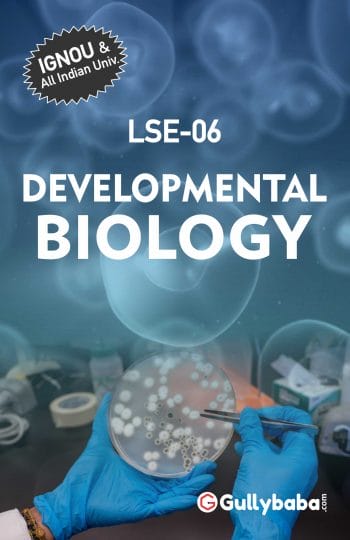#1 Best Selling IGNOU LSE-06 Help-Book & Study-Guide in IGNOU Marketplaces.
Get Good Marks in your B.Sc. Life Science Programme in the Term-End Exams even if you are busy in your job or profession.
We've sold over 39,539,702 Help Books and Delivered 48,114,938 Assignments Since 2002.
As our customers will tell you...yes, it really result-oriented.
IGNOU LSE-06 Code Details
-
University
IGNOU (Indira Gandhi National Open University)
-
Title
Developmental Biology
-
Language(s)
English
-
Code
LSE-06
-
Subject
Life Science
-
Degree(s)
B.Sc.
-
Course
Core Courses (CC)
IGNOU LSE-06 English Topics Covered
Block 1 - Plant Development-I
- Unit 1 - Anther and Ovule
- Unit 2 - Gametogenesis
- Unit 3 - Pollination and Fertilisation
- Unit 4 - Endosperm
- Unit 5 - Embryogenesis
- Unit 6 - Seed and Fruit
Block 2 - Plant Development-II
- Unit 1 - Root and Shoot Morphogenesis
- Unit 2 - Effect of Plant Growth Regulators on Development
- Unit 3 - Apical Dominance
- Unit 4 - Secondary Growth
- Unit 5 - Plant Tissue and Organ Culture
- Unit 6 - Current Trends in Developmental Studies
Block 3 - Animal Development-I
- Unit 1 - Beginning of a New Organism
- Unit 2 - Cleavage and Gastrulation
- Unit 3 - Morphogenesis and Tissue Organisation
- Unit 4 - Mechanisms of Cell Interaction
- Unit 5 - Organonensis of Eye and Limb
Block 4 - Animal Development-II
- Unit 1 - Metamorphosis
- Unit 2 - Regeneration
- Unit 3 - Growth, Aging, Cancer
- Unit 4 - Human Development
IGNOU LSE-06 (January 2024 - December 2024) Assignment Questions
Part-I (Plant Developmental Biology)
1. Define megasporogenesis. Why is it considered important for the sexually reproducing plants?
2. Differentate between gametophytic and sporophytic incompatibility.
3. What is vivipary? How does it help the mangrove species to survive in their saline/estuarine habitat?
4. Define dormancy. What is the importance of seed coat in contracting dormancy?
5. Write short note on the following:
a) Parthenocarpy
b) Cellular Totipotency
c) Senescence of Chloroplasts
d) Techniques of Plant Tissue Culture
Part-II (Animal Developmental)
6. Describe the following briefly:
i) Fate of CFU-M, L stem cells in mammals
ii) Test of genomic equivalence
iii) Role of morphogenetic field in development of eye
iv) Role of prothoracic gland in insect metamorphosis
7. Answer the following briefly:
i) List out the different germ layers present in the gastrula.
ii) Name the three zones from the outer to the inner side of neural retina.
iii) List the secondary egg envelopes in chick.
iv) What is blastema? What is its role in the regeneration of the limb in urodele (salamander)?
v) How does the Rubella virus infection in a 4-5 weeks pregnant woman affect the unborn baby?
8. Describe the following briefly:
i) Allometric and isometric growth
ii) Totipotency and pluripotency
iii) Holoblastic and meroblastic cleavage
iv) Morphollaxis and epimorphosis
9. Explain with neat, labelled diagrams the following:
i) Stages in vertebrate spermatogenesis
ii) Circulatory system changes during human development from foetal to infant stage
iii) Incomplete extensive metamorphosis in dragon files
iv) The process of cell death in the control of pattern formation of limbs
IGNOU LSE-06 (January 2023 - December 2023) Assignment Questions
Part-I (Plant Developmental Biology)
1. Differentiate between:
(i) Heartwood and sapwood
(ii) Composite and ruminate endosperm
(iii) Recurrent and non-recurrrent apomixis
(iv) Amoeboid and secretory tapetum
2. (a) What is apical dominance? Discuss the role of chemical factors in controlling it.
(b) Define polyembryony and describe its various types.
3. Make well labelled diagrams of the following:
(i) Types of ovules
(ii) Secondary growth in dicot stem
(iii) Syngamy and triple fusion
(iv) Structure of periderm
4. (a) What are cambial variants? Describe some of them with examples.
(b) Describe the major applications of plant tissue and organ culture. (5) (5)
5. Write short notes on the following:
(i) Cellular totipotency
(ii) Commercial cork
(iii) Physiological effects of two naturally occurring plant growth regulators (PGRs)
(iv) Parthenocarpy
Part-II (Animal Developmental)
6. (a) What are the major differences in the development and differentiation of an egg and a sperm?
(b) Define the following terms:
(i) Morphogenetic movements
(ii) Epiblast
7. Discuss the differentiation of an erythrocyte from a pluripotent CFU-S cell.
8. Discuss the process of mesoderm induction in amphibian embryos.
9. What is neoteny? Briefly discuss neoteny in different species of urodeles. What is the significance of neoteny in evolutionary process?
10. Write short notes on:
(i) Interstitial cells of Hydra
(ii) Neoblasts of Planaria
11. Explain that cancer is a multicausal and multistep process.
12. How is the placenta formed? What are its functions?
Buy LSE-06 Assignment
